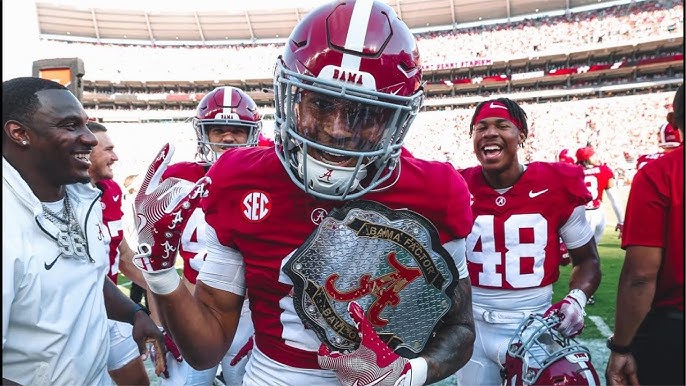Alabama football has never strayed too far from the pinnacle of college football’s recruiting hierarchy, but the Crimson Tide’s recent hot streak on the recruiting trail has sent ripples through the college football world and created renewed momentum for its 2026 recruiting class. In what has been one of the busiest and most productive Junes in recent memory, Alabama has surged up the 2026 recruiting rankings, reasserting itself as one of the premier destinations for elite talent and solidifying its standing in a rapidly evolving recruiting landscape.
The post-Nick Saban era was bound to bring with it some uncertainty, at least from the outside looking in. However, new head coach Kalen DeBoer and his staff have wasted no time proving they can maintain — and perhaps even build upon — the program’s recruiting legacy. Over the past few weeks, Alabama has secured commitments from a string of highly-touted prospects that not only boosted their 2026 class ranking, but also set the tone for what looks to be another elite haul of talent heading to Tuscaloosa.
The recruiting streak began gaining serious traction in early June when the Crimson Tide hosted several top-tier targets for unofficial and official visits. Those visits quickly bore fruit as Alabama landed multiple four-star and five-star commitments across key positions, including defensive back, wide receiver, and offensive line. The timing of these commitments could not have been more critical, as several of these prospects were trending toward other powerhouse programs before Alabama’s staff made their final push.
Among the most notable wins during this recruiting flurry was the commitment of a five-star cornerback from Texas who had long been considered a strong lean toward in-state rivals. Alabama’s ability to lure him away with a compelling vision of development and NFL preparation speaks volumes about the program’s enduring brand power and coaching appeal. That win alone sent a message to other top prospects around the country: Alabama still gets who it wants.
Then came a run on skill players. A pair of elite wide receivers — both ranked in the top 50 nationally — gave their pledges within days of each other, citing Alabama’s offensive philosophy and recent history of sending receivers to the NFL as key factors. The addition of these pass-catchers gave Alabama’s 2026 class a significant boost in both points and perception, helping vault the Tide into the top 3 of several national class rankings.
Meanwhile, on the other side of the ball, Alabama didn’t let up. The defensive line class started to take shape with the commitment of a dominant four-star edge rusher from Georgia who had drawn interest from SEC rivals like Georgia, LSU, and Tennessee. His commitment signaled that Alabama is not just trying to match talent with its rivals — it’s aiming to outpace them in both quantity and quality.
The combination of offensive skill players, defensive stalwarts, and trench anchors gives Alabama’s 2026 class a balance that few other programs can match at this stage. The class is shaping up to include players from across the country, a testament to the national reach of Alabama’s recruiting footprint even in the face of intense competition and NIL-era volatility. From California to Florida and Texas to the Midwest, Alabama has been able to sell a consistent message that resonates with players and their families.
Perhaps even more impressive than the individual commitments themselves is how Alabama has been able to sustain momentum. In the recruiting world, timing matters. When a program starts stacking commitments close together, it can generate a snowball effect. Players see who else is joining the class, they feel the momentum, and they want to be a part of something special. That’s exactly what Alabama has accomplished in recent weeks.
This streak has not only moved Alabama up the recruiting rankings but has also started to shift the narrative around the program post-Saban. There were valid questions about how the transition to DeBoer would impact Alabama’s standing among elite high school players, especially in the South where relationships often begin during a player’s freshman or sophomore year. But those concerns are quickly fading as DeBoer and his staff continue to close on elite-level targets.
Behind the scenes, recruiting insiders have praised Alabama’s organization and adaptability. The new staff brought with them a fresh approach while still respecting the foundational elements that have made Alabama a recruiting giant. From utilizing advanced analytics to tailoring presentations to families based on NFL projections and player development plans, Alabama has modernized without compromising its edge.
NIL, which has become a massive factor in modern recruiting, was once perceived as an area where Alabama may lag behind programs with more aggressive collectives. However, recent commitments suggest that the program has found a balance — leveraging its prestige and development track record while also remaining competitive in the financial incentives space. Recruits now see Alabama as a place where they can get to the NFL, win championships, and also benefit from NIL opportunities without distractions.
Looking at the numbers, Alabama’s 2026 class currently features more than a dozen blue-chip recruits and continues to trend upward. Recruiting services have noted that the Crimson Tide’s average player rating is among the highest in the country, meaning that Alabama isn’t just stacking numbers — it’s landing elite-level players at an unmatched rate.
As we look toward the remainder of the summer and into the fall, Alabama is well-positioned to add even more star power to its 2026 class. Several top 100 prospects who visited in June are trending toward Alabama, and there are whispers that additional five-star commitments could be on the way before the end of July. If that happens, the Crimson Tide could easily lock in the No. 1 class for 2026 before the season even begins.
This aggressive and successful early recruiting also impacts the program in other key ways. For one, it gives Alabama stability and continuity that allows the staff to focus on team development and game planning once the season begins. With much of the class wrapped up early, there’s less pressure to scramble in December, giving coaches a chance to reinforce relationships and ward off late pushes from other programs.
It also gives Alabama leverage with future classes. High school underclassmen pay attention to where top talent is going, and when a program lands multiple five-star players, it creates a gravitational pull. Younger players want to play with other great players, and Alabama’s momentum in 2026 can have a domino effect on 2027 and beyond.
Perhaps most significantly, Alabama’s recent recruiting success is a reminder of what separates the true blue-bloods from the rest of the pack. Programs like Alabama, Georgia, Ohio State, and others are able to reload quickly, even in the midst of coaching changes or external shifts like NIL and transfer portal upheaval. Alabama’s June recruiting streak has reasserted its place among that elite tier and silenced any talk of decline.
For Alabama fans, this recruiting surge offers reason for optimism and excitement. Not only is the program maintaining its elite standard, but it’s doing so in a way that promises sustained success. The 2026 class could very well be one of the deepest and most talented in recent memory, and it’s a credit to the new coaching staff’s vision, preparation, and execution.
In the end, recruiting is the lifeblood of college football. Championships are won with talent, and talent is secured on the recruiting trail. Alabama’s recent hot streak is more than just a series of verbal commitments — it’s a statement to the rest of the college football world that the Crimson Tide are still rolling.



